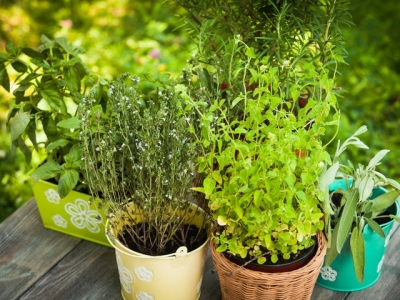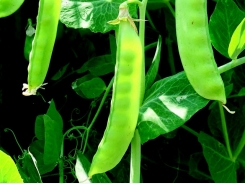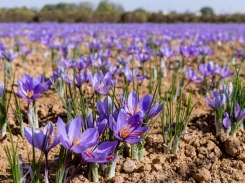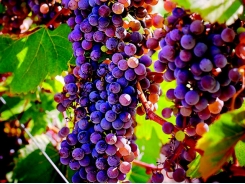7 Perennial Herbs to Plant Now

Perennial herbs will come back year after year if you take care of them right. (Note: This is a stock photo; not all herbs pictured are perennials. Please read the story for more information, and thank you.) By Oksana Shufrych / Shutterstock.com
Growing vegetables successfully takes ample dedication and a fair bit of growing space plus the knowledge to do it right. And once they run out, you have to plant them again! No so with perennial herbs!
Annual herbs like basil and dill must be planted anew each year, but most other commonly used herbs qualify as perennials. They will go dormant where winters are cold, only to perk back up again each spring.
You have two options when it comes to starting perennial herbs: You can plant them directly in the ground or grow them in pots. Early spring is the best time to plant outdoors, but you can put the herbs in the ground any time of year that it’s not frozen. If going the potted route a great option for those in colder regions looking to get started right away, or anyone who wants year-round harvests make sure there’s a sunny window (or grow lights) available.
"arvest no more than 10% of the plant at a time if you want it stay alive and thriving."
The small stature of perennial herbs make them great candidates for windowsills, patios, balconies, and decks. All of the following varieties will thrive in two- to three-gallon containers. Instead of running to the store when you need a sprig of this or that, simply step out your back door. Just remember, you can only harvest a small portion of the plant at one time ideally no more than 10 percent if you want it stay alive and thriving.
Lavender
Uses: Flavoring for beverages and desserts; flowers may be used in dried arrangements, and herbal remedies, like tinctures
Growing Instructions: Plant in well-drained soil in a sunny location; cut off the flower stalks as they fade
Tip to Keep It Thriving: Lavender likes its soil on the dry side be careful not to overwater
Bonus: Lavender blossoms are very attractive to butterflies
Sage
Uses: Meat, pasta sauces, and other savory dishes
Growing Instructions: Plant in well-drained soil in a sunny location
Tips to Keep It Thriving: Cut the stalks back by about 30 percent each fall to encourage lush new growth
Bonus: There are many varieties of sage besides the standard culinary herb try pineapple sage for iced tea
Rosemary
Uses: An essential ingredient in many savory dishes; the woody stalks of the plant can be cut for use as flavor-enhancing shish kebab skewers
Growing Instructions: Plant in well-drained soil in a sunny location
Tips to Keep It Thriving: Rosemary likes its soil on the dry side be careful not to overwater
Bonus: Try one of the low-growing, spreading rosemary varieties, such as ‘Prostratus’, for an aromatic groundcover
Mints
Uses: Flavoring for beverages and desserts
Growing Instructions: Plant in part shade and irrigate several times per week during hot, dry weather; tolerant of poorly drained soil
Tips to Keep It Thriving: As long as they have moisture, mints are hard to kill; more important is to know that you must plant them in pots if you don’t want them spreading all over the yard
Bonus: Lemon balm, a mint relative, provides a citrusy zest for your favorite iced beverage
Thyme
Uses: An essential ingredient in many savory dishes, especially those that hail from Italy
Growing Instructions: Plant in well-drained soil in a sunny location
Tips to Keep It Thriving: Cut the stalks back 50 percent in fall to encourage lush new growth
Bonus: This low-growing plant is an excellent groundcover for planting between steppingstones, where it will release its delicious fragrance each time you walk by
Oregano
Uses: An essential ingredient in many savory dishes, especially those that hail from Italy
Growing Instructions: Plant in well-drained soil in a sunny, or partly sunny, location
Tips to Keep It Thriving: Cut the stalks back 30 percent after they flower in summer
Bonus: Oregano has a drooping habit that is attractive in hanging baskets
Chives
Uses: Unparalleled in omelettes; use in any dish where you’d like to add a bit of onion flavor
Growing Instructions: Plant in a sunny location and irrigate at least once per week during hot, dry weather
Tips to Keep It Thriving: Chives grow from fleshy roots that can become overcrowded when confined in a pot divide the roots into fist-size clumps and pot them up in fresh soil every two or three years
Bonus: The purple flowers also possess a light onion flavor toss them in salads as a garnish
Related news
Tools

Phối trộn thức ăn chăn nuôi

Pha dung dịch thủy canh

Định mức cho tôm ăn

Phối trộn phân bón NPK

Xác định tỷ lệ tôm sống

Chuyển đổi đơn vị phân bón

Xác định công suất sục khí

Chuyển đổi đơn vị tôm

Tính diện tích nhà kính

Tính thể tích ao




 Grow Lights for Indoor Plants and Indoor Gardening:…
Grow Lights for Indoor Plants and Indoor Gardening:…  Cropped: How to Grow Cold-Hardy Wine Grapes
Cropped: How to Grow Cold-Hardy Wine Grapes